Nature Conservation 2025 — 31. 7. 2025 — Nature and Landscape Management — Print article in pdf
The Pitfalls in Protecting, Conserving and Managing the Highest Parts of the Czech Republic
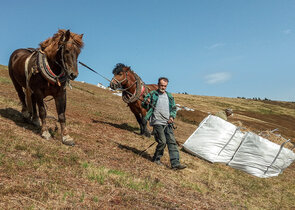
In June 2024, a two-phase “consilium/review board” attended by leading experts was held in the Jeseníky and Krkonoše/Giant Mts. on the needs and possible ways of preserving and restoring biodiversity in the Alpine zone in both mountain ranges. The reason for convening this consultation was the ongoing changes in the vegetation of the Alpine treeless habitats over the last decades. Their probable drivers include the abandonment of long-term farming after the displacement of the German population after World War II and other societal changes in the 20th century, as well as in the increasingly rapid and pronounced global changes, particularly the increase in temperature and high atmospheric nitrogen deposition.
The need to translate the external drivers into conservation practice has been demonstrated by the rate and the intensity of ongoing vegetation change, as identified through evaluating ongoing monitoring and scientific studies. Countering the overgrowth of the Alpine zone with active measures would mean, particularly in the Krkonoše/Giant Mts., a fundamental change in the current approach to its protection, conservation and management.
Jeseníky Mountains (northern Moravia and southern Silesia)
A short look into the history
A study of archival materials (Szabó et al. 2024) shows that the history of exploitation of the highest altitudes of the Jeseníky Mountains has at least been 700 years long. Over the centuries, the ridges have been burnt, grazed by oxen, harvested for hay or farmed in the so-called Alpine style. The intensity of farming in different parts in the treeless areas has varied considerably over this period, depending on property ownership, because the main driving force was not demand from the common people in the foothills, but rather the desire of the estate owners to make the most efficient economic use of their land. Farming on the Jeseníky Mts. ridges then ceased completely for many decades shortly after the World War II.
When Leo Bureš and Jan Jeník created a detailed map of the vegetation in the Velká kotlina/Great Basin Glacial Cirque in 1974 (Bureš 2022), they may not have known what a timeless work it was. In 2009, a new map was produced with the most accurate repetition of the methodology and the results of the comparison after 35 years definitely confirmed that the Alpine treeless area in the Jeseníky Mts. is indeed changing significantly. The comparison of the two mapping surveys not only showed an area-wide loss of species-rich vegetation types, but the repetition of the phytocenological images also showed that even where different types of Alpine grasslands were preserved, there was a decrease in the number of species (species richness). The change in vegetation structure was most evident in the onset and relatively rapid spreading of the European bilberry (Vaccinium myrtillus).
At the same time, in 2009, long-term data from experimental plots showed that active management (mowing) clearly promotes the survival of rarer and competitively weak species. The first 5 such plots, where the effect of mowing on the species composition of subalpine vegetation was monitored, had been established by Leo Bureš in Cimrmanova zahrádka/Cimrman’s Garden on the edge of the Velká kotlina/Great Basin Glacial Cirque as early as 1990, and gradually more were added in various places without forests, e.g. at Vysoké Hole/High Meadow in 2004.
Since 2010, the mowed areas, which had been limited to experimental plots, have begun to expand to other areas with still surviving rare species, e.g. the Narcissus-flowered anemone (Anemonastrum narcissiflorum), Small white orchid (Pseudorchis albida), Bearded bellflower (Campanula barbata), Round-headed rampion (Phyteuma orbiculare), the Mountain pansy (Viola lutea subsp. sudetica), etc., aiming at stopping the overgrowth of these areas, especially with blueberries. By 2015, mowing was already being carried out on 3-4 hectares per year.
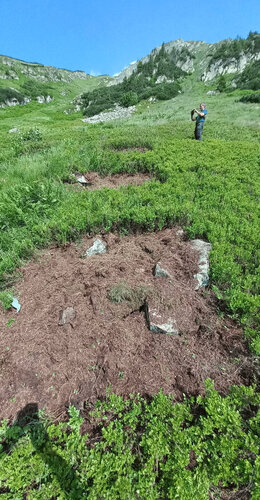
Sites with removed blueberry in the Malá kotelní jáma/Little Kettle Cirque Hole in the Krkonoše/Giant Mts. in 2022. © Stanislav Březina
Return of area management interventions on the Jeseníky Mts. peaks
A breakthrough in the management setup occurred in 2015, when the first eradication of blueberry on an area of approx. 0.5 ha had taken place as part of the testing of management practices. Between 2017 and 2023, mowing was already underway at a rate of approximately 5-17 ha per year. In doing so, it has become apparent that complete suppression of bilberry is a long haul, and that repeated mowing of areas with bilberry is necessary to weaken it and stop its further spread.
In parallel with mowing, grazing is gradually being reintroduced in the Mt. Praděd/Great Grandfather National Nature Reserve. In 2012, cattle grazing began on the meadows near the Švýcárna site, since 2014 sheep have been grazing above the Ovčárna site and since 2019 a mixed herd of horses and cattle has been grazing on the slopes of Mt. Praděd/Great Grandfather. The impact of grazing activities on the natural environment has also been monitored and evaluated annually since the beginning.
A small but definitely interesting management measure was the complete removal of the turf at five sites with a total area of 0.4 ha in the upper part of Vysoké Hole/High Meadow in 2017 and subsequently on an area of 0.5 ha in 2024.
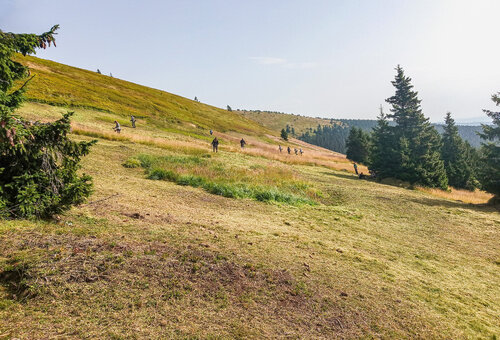
Grassland and blueberry growths mowing above the timberline at the Cimrmanova zahrádka/Cimrman Garden site. © Radek Štencl
The results of the regular whole-area mowing are more than encouraging
After nine years of whole-area mowing, one of the expected assumptions has been confirmed, i.e. that not all Alpine grassland types need to be mowed annually and some vegetation types do not need mowing at all. The Alpine environment is conservative and processes are slower than at lower altitudes. To maintain stable vegetation types and prevent their degradation and species decline and loss, it will be sufficient to mow e.g. once every two or three years. The fact brings the advantage that, despite the financial demands of mowing in remote ridge locations, with an appropriate rotation, management can be optimised so that the biodiversity hotspots maintenance within the approx. 800 hectares of treeless areas in the Mt. Praděd/Great Grandfather region is sustainable in the long term.
However, almost all areas of Alpine treeless forest in the Jeseníky Mts. are registered as forest land. In order to allow grazing, which in this case is an intervention necessary to maintain and improve the condition of the objects of protection/conservation, it is therefore necessary to apply annually for a ‘temporary restriction in providing forest functions’ and to pay for this restriction (e.g. more than CZK 3,500 per hectare and month in 2024), which unfortunately makes grazing considerably more expensive.
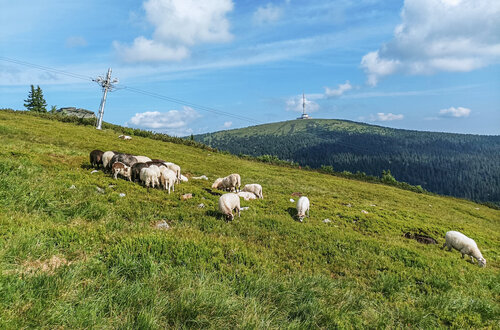
In 2024 free-ranging grazing by sheep was tested in the vicinity of the Petrovy kameny/Peter’s Stones site. © Jindřich Chlapek
An optimistic outlook
The next step towards the restoration of the species-rich subalpine grasslands is a five-year project funded by the Operational Programme Environment (OPE), starting in 2024, which aims to gradually expand and regularly carry out mowing on an area of 25 hectares and to the same extent carry out cattle and horse grazing on the south-western slopes of Mt. Praděd/Grand Grandfather and free grazing of sheep in the vicinity of the Petrovy kameny/Peter’s Stones site. The OPE allows to finance projects for the protection and improvement of the environment from the European Union’s Structural Funds.
The idea for the period after 2029 is to resume year-on-year rotational free grazing on areas of dozens of hectares, perhaps with only additional mowing the plots where it has not been done yet and ideally with the production of local dairy products. This phase could mark a definitive shift from experimentation and conservation management to restoration of farming without the need for financial support beyond agricultural subsidies.
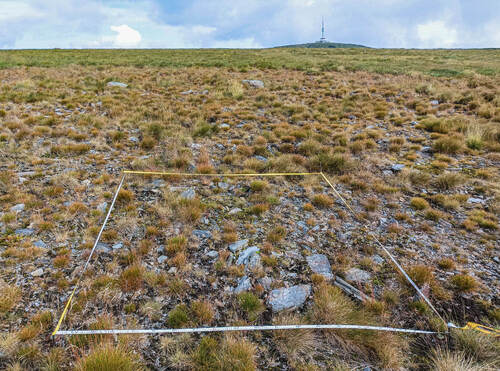
State of vegetation at the Vysoká Hole/High Meadow: vegetation was fully removed thus denuding the mineral substrate 7 years ago. © Jindřich Chlapek
Krkonoše/Giant Mountains (eastern Bohemia)
The key question of human influence on the current form of the Krkonoše/Giant Mts. Alpine treeless area
In the mid-1990s, when conservationists in the Velká kotlina/Great Basin Glacial Cirque in the Jeseníky Mts. started their first management experiments, an important summary text (Soukupová et al. 1995) was published from the perspective of the Krkonoše/Giant Mts., which is the result of comparative studies, long experience of the main authors and extensive confrontation with the literature. A team of experts around geologist and polar explorer Josef Sekyra and geobotanist Jan Jeník, it presents the Krkonoše/Giant Mts. parts above the timberline as, i.e. as a unique area with elements of both mountain and northern tundra (for more details see Březina et al. 2023 and Materna et al. 2023). The impact of humans on the sensitive tundra environment is assessed as clearly negative, especially in relation to ruderalization, eutrophication and trampling of vegetation around numerous paths or buildings. There is no mention in the text of at least 300 years of human influence on the Krkonoše/Giant Arcto-alpine tundra ’s development or current shape.
Paradoxically, the unnoticeable role of humans managing the area above the Krkonoše/Giant Mts. timberline is recalled by Theodor Lokvenc, doyen in researching the past Krkonoše/Giant Mts. landscape (Lokvenc 1995). The mountains have been grazed and used for haymaking for centuries in the past. A rough idea of the extent of human activity at that time is given by the extent of the area with felled dwarf mountain pines (Pinus mugo) (either for the expansion of pastures and meadows or for fuel), which, according to Lokvenc covers up to 1,000 hectares, i.e. approx. a quarter of the entire Krkonoše/Giant Mts. area above the timberline. However, even he considers the human impact as rather negative, since the felling the Dwarf mountain pine has moved the vegetation in these parts away from its original state before the arrival of man. According to the state of knowledge at that time, the vegetation cannot return to this state on its own due to the lack of or very rare natural regeneration of the Dwarf mountain pine. One of the aims of the paper was therefore to justify the Dwarf mountain pine’s artificial replanting, which was then carried out intermittently throughout the 20th century. In the background there is a conviction that the best we can do for Krkonoše/Giant Mts. nature is to undo the consequences of historical human influence and otherwise leave it to itself, or to the free action of natural processes that have shaped it over the previous millennia. This attitude is also evident both in the decree of the Government of the Czech Republic that legislated the establishment of the Krkonoše/Giant Mts. National Park in 1991 and in the contemporary planning documents elaborated by the Krkonoše/Giant Mts. National Park Administration.
A parallel in the approach to the secondary forestless area in the Krkonoše(Ginat Mts.
The strength of the “protection” spirit in nature conservation at that time is also evidenced by the cautious way in which the Krkonoše/Giant Mts. mountain meadows was started after the Velvet Revolution, where today we no longer doubt the necessity of active management. After World War II, the mountain meadows were abandoned by traditional farmers and since then many of them have been overgrown at different rates, first with expansive herbs and grasses, then with scrub and finally with forest. As late as the 1990s, only a fraction of the total area of about 11,000 hectares was managed by the Krkonoše/Giant Mts. National Park Administration. It was only with the LIFE CORCONTICA project (implemented 2012-2018) that meadows in the Krkonoše/Giant Mts. enclaves received comprehensive and conceptual management.
On the other hand, “up there” in the tundra, a firm belief in the optimality of the non-intervention regime persisted until recently. And rightly so. Evidence is mounting of how even well-intentioned human interventions in sensitive tundra habitats can be tricky in their effects. Dwarf mountain pine growths planted after World War II have gradually become closed and have begun to have a similarly deleterious effect on the unique tundra vegetation in their vicinity as the sprawling spruce trees “down below” in the meadow. After years of careful background data gathering and heated debate between naturalists and foresters, the risks from the Dwarf mountain pine’s further expansion became too high, and a multi-phase project to reduce it over a total area of 160 hectares was initiated (Materna et al. 2023) ending with a third phase in 2022.
The results of comparative studies and monitoring speak unequivocally
Only the recent results of the Krkonoše/Giant Mts. Tundra - Past, Present and Future project have recently shown that there may not be an automatic equation between the Krkonoše/Giant Mts. tundra and the non-intervention regime under changing circumstances. Changes in its vegetation are not limited to areas with artificially planted dwarf mountain pines. Common woody plants, shrubs and grasses are spreading and unique tundra species, many of which being a direct target of the Krkonoše/Giant Mts. National Park activities, have been declining even at sites where no one has directly planted dwarf mountain pines - in Dwarf mountain pine’s natural stands, in closed Alpine grasslands, on the highest Krkonoše/Giant Mts. peaks and in cirques, i.e. basically across the whole area (cf. Potůčková et al. 2021, Březina et al. 2023). It seems that while until recently, the changes have been relatively slow and gradual and there was hope that this was a return to a natural equilibrium state, in recent decades and years they have accelerated. As recently as the 1990s, the spread of blueberry or Norway spruce was not mentioned as a major problem (Wojtuń et al. 1995).
T answer the important question of whether we even have suitable management options to counteract the decline in rare Alpine plant species in the tundra, it is enough to go to the Jeseníky Mountains. Let us also reiterate that the current extent of mountain grasslands in the Krkonoše/Giant Mountains is, inter alia, the result of several hundred years of management. Part of the current changes in vegetation must be attributed to acid rain or nitrogen deposition and, of course, the increasingly intense global climate change. At the same time, however, they are all very reminiscent of the simple vegetation succession after the displacement of traditional farmers, i.e. what happened a few decades earlier in the Krkonoše/Giant Mts. meadows. Thus, the unique cold-adapted plant species are not likely to disappear as a direct result of climate change (warming), but rather due to overgrowth by common, competitively stronger species of shrubs, herbs and grasses, which we can cope with by similar management means as in the Alpine meadows below.
Conclusions of the tundra “consilium/review board”
The fundamental conclusion of the Krkonoše/Ginat Mts. part of the “consilium/review board” is that this is exactly what we should try to do in pilot management experiments as soon as possible. The ideal model species for such interventions are in the Czech Republic the specially protected species – the Sudetic lousewort (Pedicularis sudetica subsp. sudetica) and the Narcissus-flowered anemone. However, a comprehensive analysis of all tundra species should be made and consideration given to selecting additional species and their habitats (e.g. heathland in place of blown grassland) to cover the variability in possible approaches and outcomes. The size of areas for pilot interventions should be in from hundredths to tenths of hectare, interventions should primarily involve mowing and turf disturbance, grazing may also be considered. Interventions can be one-off, intermittent (approx. once every 3-5 years) or repeated, e.g. annually for approx. 3 years at the experiment’s beginning and then leave the site unintervened for several years. The aim is to verify the actual impacts/effects on the selected specially protected species. The key point is that, according to the opinion of the Ministry of the Environment of the Czech Republic’s staff present, none of the various proposed experiments to be carried out on the scale of hundredths of hectare is in conflict with the statutory nature zone regime, including the requirement for the implementation of such measures to be exceptional on the grounds of nature conservation interests.
Will the Jeseníky Mts. be a model for the Krkonoše/Giant Mts.?
The above information clearly shows a more progressive approach of the Jeseníky Mts. nature conservationists to the active management of the Alpine treeless habitast compared to the Krkonoše/Giant Mts., which was confirmed by the independent experts present at the ‘consilium/review board’. In the Krkonoše/Giant Mts., all participants of the event unanimously recommended to go the way of small-scale pilot experiments in favour of specially protected species. These are intended to show whether simple interventions will bring the desired results even under the Krkonoše/Ginat Mts. conditions. While there was a consensus among the participants of the Krkonoše/Giant Mts. ‘consilium/review board’ on pilot interventions, there were divergent ideas on the longer-term vision and the introduction of active management interventions. The Krkonoše/Giant Mts. National Park Administration is thus facing a thorough discussion on the vision of the whole tundra area in the light of new circumstances. ■
- - - -
Cover photo: Removal of mowed matter from upper parts of the Velká kotlina/Great Basin Glacial Cirque where biomass could not be left due to risk associated with eutrophication. © Radek Štencl
- - - -
The list of references is attached to the online version of the article at www.casopis.ochranaprirody.cz

